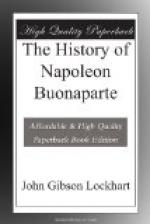The French Directory heard with indignation that any semblance of sovereignty was still left to an enemy whose weakness had been made so manifest. But Buonaparte had now learned to act for himself. He knew that any formal dethronement of the Pope would invest his cause with tenfold strength wherever the Romish religion prevailed; that a new spirit of aversion would arise against France; and that Naples would infallibly profit by the first disturbances in the north of Italy, to declare war, and march her large army from the south. He believed also—and he ere long knew—that even yet Austria would make other efforts to recover Lombardy; and was satisfied, on the whole, that he should best secure his ultimate purposes by suffering the Vatican to prolong, for some time further, the shadow of that sovereignty which had in former ages trampled on kings and emperors.
[Footnote 11: Buonaparte, to replace all his losses in the two last campaigns, had received only 7000 recruits.]
[Footnote 12: He found among them a wealthy old canon of his own name, who was proud to hail the Corsican as a true descendant of the Tuscan Buonapartes; who entertained him and his whole staff with much splendour; amused the general with his anxiety that some interest should be applied to the Pope, in order to procure the canonisation of a certain long defunct worthy of the common lineage, by name Buonventara Buonaparte; and dying shortly afterwards, bequeathed his whole fortune to his new-found kinsman.]
[Footnote 13: Hence, in the sequel, Massena’s title, “Duke of Rivoli.”]
[Footnote 14: Such was the prevailing terror, that one body of 6000 under Rene surrendered to a French officer who had hardly 500 men with him.]
[Footnote 15: The priests had an image of the Virgin Mary at this place, which they exhibited to the people in the act of shedding tears, the more to stimulate them against the impious Republicans. On entering the place, the French were amused with discovering the machinery by which this trick had been performed; the Madonna’s tears were a string of glass beads, flowing by clockwork within a shrine which the worshippers were too respectful to approach very nearly. Little ormolu fountains, which stream on the same principle, are now common ornaments for the chimney-piece in Paris.]
[Footnote 16: The Santa Casa, or holy house of Loretto, is a little brick building, round which a magnificent church has been reared, and which the Romish calendar states to have been the original dwelling-house of the Virgin Mary in Nazareth, transported through the air to Italy by miracle. This was for ages the chief resort of Romish pilgrims, and the riches of the place were once enormous.]
CHAPTER VIII
Neutrality of Venice—The
Archduke Charles—Battle of
Tagliamento—Retreat
of the Archduke—Treaty of Leoben—War
with
Venice—Venice
conquered.




